Trainers Say These Stretches Work For Pregnancy Aches In Every Trimester

Expecting a little one comes with a whole lot of emotions (thanks, hormones!) and physical changes. Your growing belly is just one of the many ways your body transforms. And with that, soreness often follows. Luckily, a consistent stretching routine throughout pregnancy can help alleviate some of the less-pleasant side effects. As a bonus, pregnancy stretches prep the body for labor and delivery and postpartum recovery.
Prenatal stretching is an excellent way to minimize common pregnancy discomforts, such as back soreness, tight chest muscles, and pelvic pain, says Macy Pruett, CPT, a pre- and postnatal certified personal trainer and the founder of Fittest Core. “Strength and endurance are also important when preparing the body for birth but having flexible and responsive muscles that allow space in the pelvis, and that are able to yield, is essential.”
Meet the expert: Macy Pruett, CPT, is a pre and postnatal certified personal trainer and the founder of Fittest Core.
There are constant adjustments over the nine months, but two of the biggest changes result from a shifting in the body’s center of gravity, says Pruett. “A growing belly and breasts leads to thoracic kyphosis, which is rounding or hunching of the shoulders, and this rounding can cause tightness in the chest and weakness in the upper back.” The other major change is an anterior pelvic tilt which causes a swayback posture (a.k.a., lumbar lordosis), adds Pruett. “Standing with a swayback can cause lower back pain, result in inactive glutes, and shorten the pelvic floor, all of which we don't want.” And, you guessed it, stretching helps alleviate all of those issues.
That said, you can take a stretch too far. If a position ever feels uncomfortable or painful, decrease the range of motion or stop the movement altogether, says Pruett. “A stretch should cause a feeling of a ‘good stretching pull,’ but never so much so that it's causing pain.” If you have any pre-existing conditions or injuries, be sure to talk with your doctor.
11 Best Pregnancy Stretches
Now that you know why stretching through all three trimesters is so beneficial, here's exactly how to do it right. These are the most effective pregnancy stretches from a prenatal-certified trainer for sweet relief week after week.
Pro tip: Balance becomes more difficult the further you get into pregnancy, so make sure you add support (like a wall or chair to stabilize) for any movements you feel wobbles, says Pruett.
1. Ear To Shoulder

Why it rocks: As your breasts grow during pregnancy, your center of gravity shifts and you may feel more tension in the neck and shoulders, says Pruett. “This stretch helps relieve that tension and can also be beneficial [postpartum] when breastfeeding is done so regularly.”
How to:
Sit on a stability ball or chair with a neutral pelvis.
Drop your right ear down to your right shoulder. (You should feel lengthening on the left side of your neck and shoulders immediately.)
For a deeper stretch, extend the right arm down the side of your body.
Hold for 10 to 30 seconds, then slowly drop your chin toward your chest and gently bring your head back to center.
Repeat on the other side. That's one rep.
Continue alternating sides for 3 to 5 reps.
2. Rotate And Reach
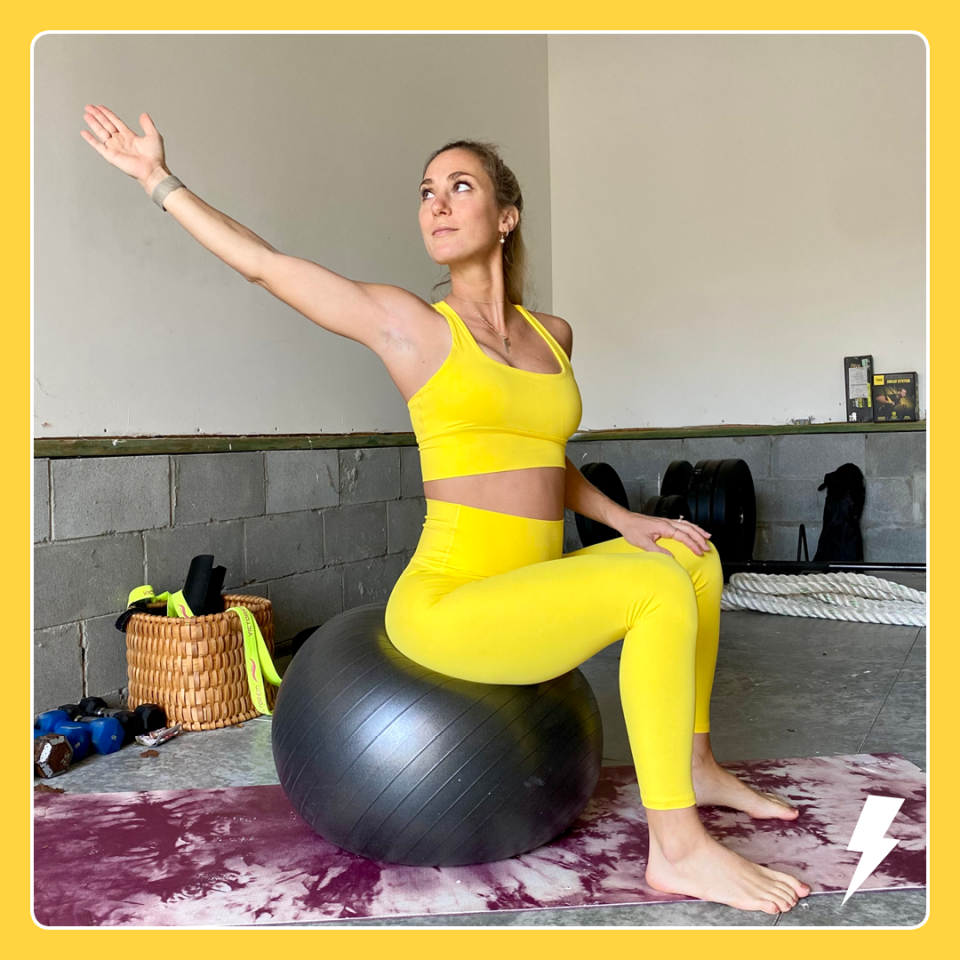
Why it rocks: Postural changes are normal when pregnant but, as a result, the thoracic (mid-back) area can get especially stiff. “Doing rotation stretches, such as this one, helps in alleviating that stiffness," says Pruett. "The stretch also helps create length and release in the torso for better breathing and freedom of movement in general.”
How to:
Sit on a stability ball or chair with a neutral pelvis.
Extend your right arm and gradually reach up to the ceiling while rotating your torso to the right. Only go as far as you can without the right butt cheek coming off the ball or chair.
Hold for 3 to 5 seconds, then gently return to starting position.
Repeat on the other side.
Continue alternating sides for 3 to 5 reps.
3. Shoulder And Chest Stretch With Band
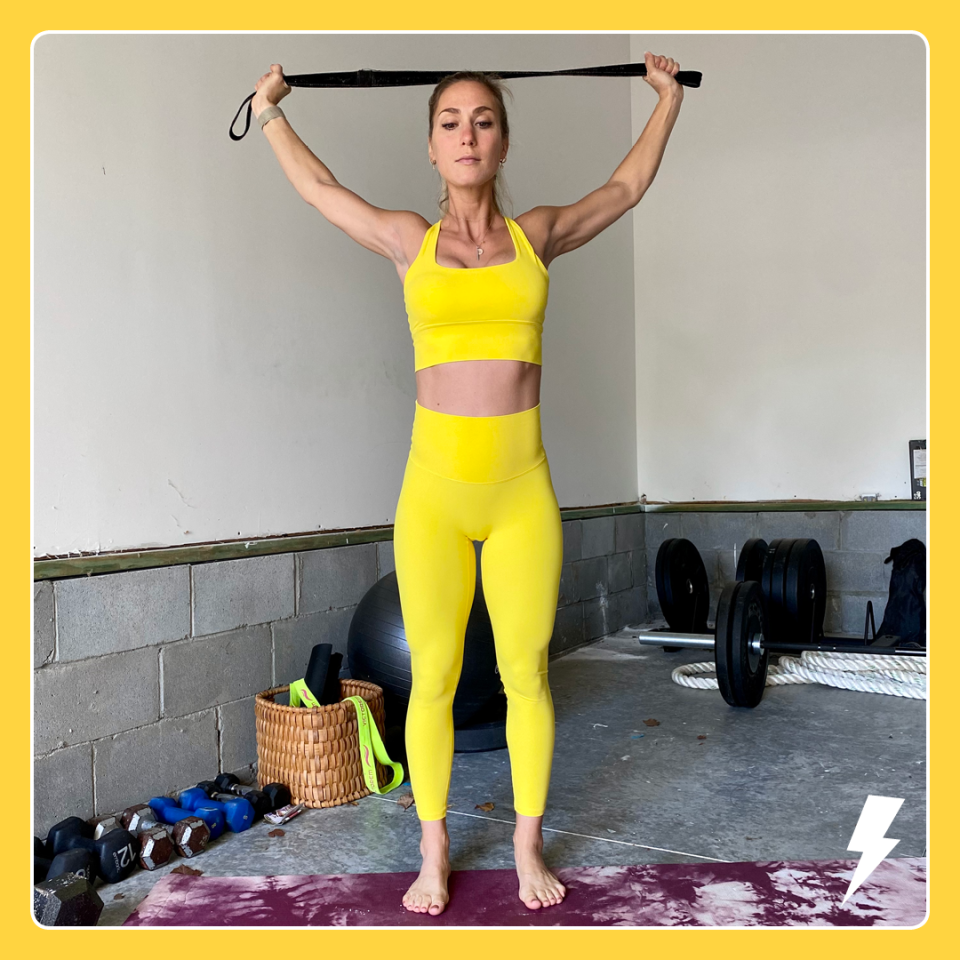
Why it rocks: “The neck and shoulders are tight in most people, but increasingly so in pregnant women due to the shifting of the center of gravity and growing breasts,'' says Pruett. This upper-body opener is great for all trimesters and postpartum to help to free up tension in the shoulders and release the chest.
How to:
Stand with a neutral pelvis and hold a band or strap in each hand, slightly wider than shoulder-width apart and palms facing down.
Keep the arms almost completely straight as lift them up over your head.
Hold them overhead for a few deep breaths while maintaining upright posture.
Slowly lower arms to return to the starting position. That's one rep.
Repeat for 10 reps.
4. Standing C-Stretch
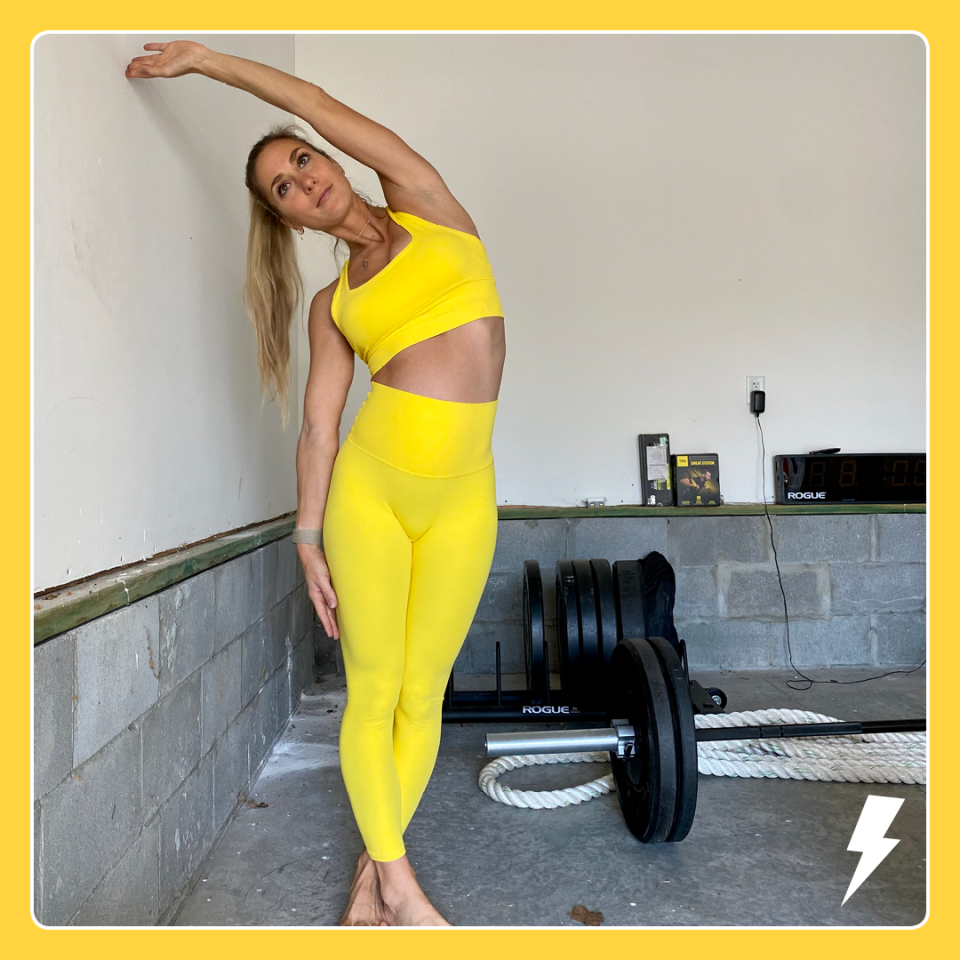
Why it rocks: Pregnancy often leads to more sitting and compensation in the core area again, due to the shifting of center of gravity, says Pruett. “The combination of these two can mean rigidity in the torso, especially in the obliques, so this is a great way to create length in the side of the body and free up space for better breathing.”
How to:
Stand next to the wall with your right leg about one foot away from the wall.
Place your right hand on the wall just below shoulder height and cross the left foot over your right.
Allow the left hip to shift away from the wall as you reach your left arm up and over your head. (Your body will curve away from the wall in a “C” shape.)
Hold for 10 to 30 seconds. That's one rep.
Repeat for 3 to 5 reps on right side, then switch to the left side for 3 to 5 reps.
5. Seated Chest Stretch Over Stability Ball

Why it rocks: If you’re looking to open up the chest, manage postural changes, and let out tension in the upper neck and shoulders, then this stretch is for you, notes Pruett. It’s also another great one to continue postpartum.
How to:
Sit on the floor with your back against the stability ball in a semi-reclined position with your feet on the floor in front of you.
Gently clasp your hands behind your neck and rest your head on the ball allowing your elbows to open to the sides and chest to expand.
Let yourself slowly roll back into the ball and hold for 10 to 30 seconds. That's one rep.
Repeat for 3 to 5 reps.
6. Side-Lying Stretch Over Ball Or Pillow
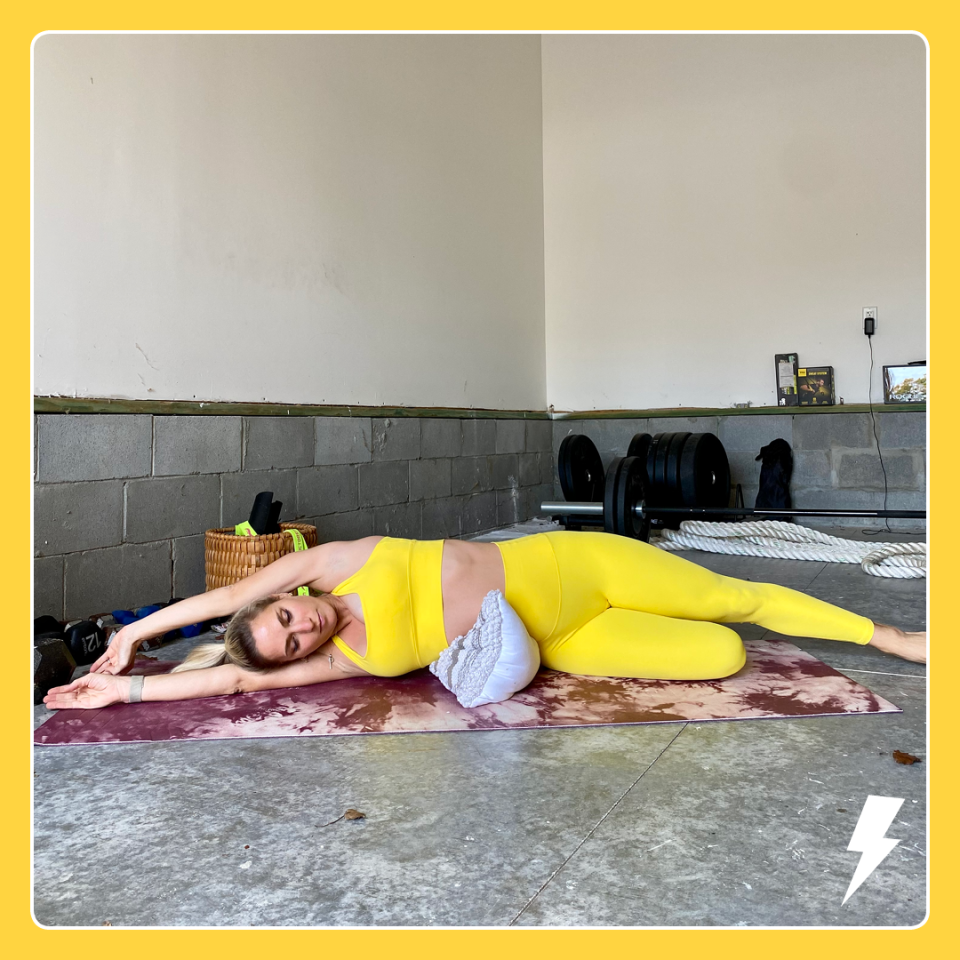
Why it rocks: A full-body stretch and a moment of relaxation? Dreams do come true. This stretch is guaranteed to loosen your entire bod while giving you a chance to rest, notes Pruett.
How to:
Sit on the floor and place a pillow (or foam roller) between the top of your pelvis and the bottom of your rib cage (on your waist) on your right side.
Slowly lie down on your right side with the pillow between you and the floor.
Rest your head on right arm and bend the right leg (the bottom leg) for support.
Lengthen the left leg (top leg) straight out and reach the left arm (top arm) to rest over your head. Hold for 30 to 90 seconds.
Slowly press yourself back up to sitting using your right arm.
Repeat once on the other side.
7. Calf Stretch
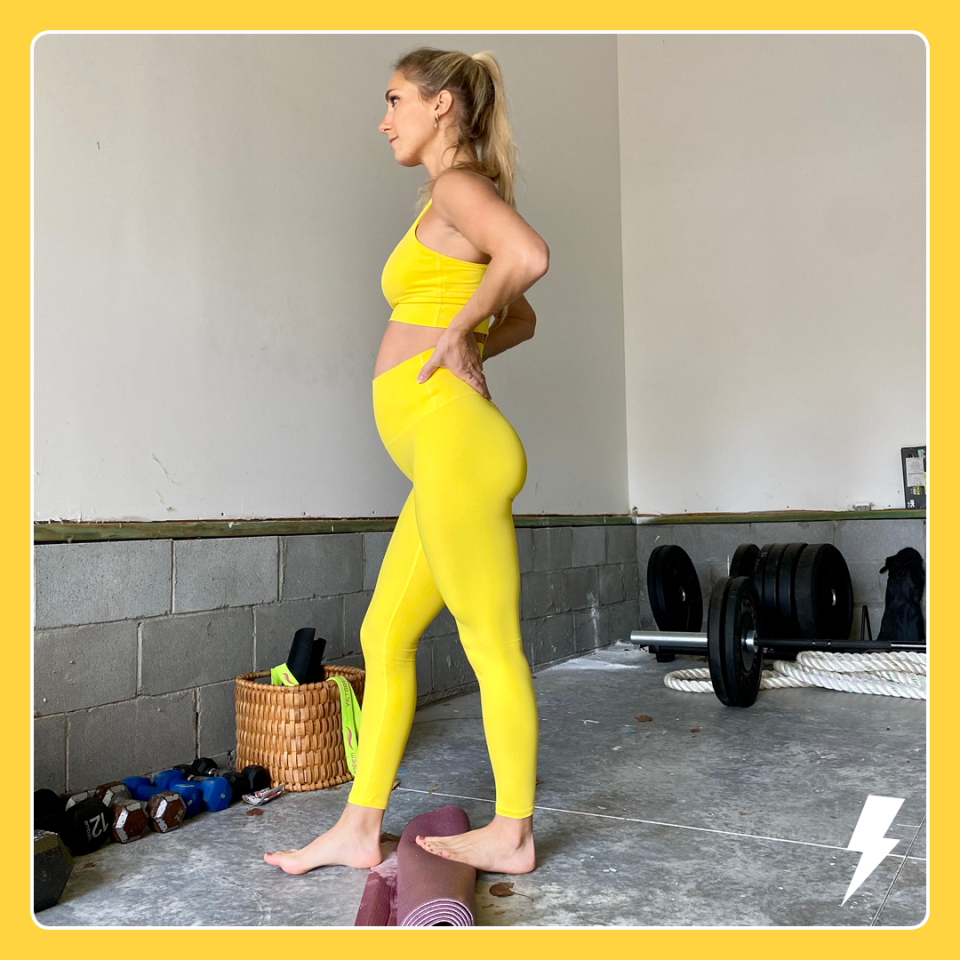
Why it rocks: There are multiple benefits to limber calves. “The more length you have in your calves, the longer your foot can stay on the ground as you walk,” says Pruett. “This flexibility translates to greater efficiency and a better push-off [as you walk], which also means more length in the back of the legs so the pelvis can find and stay in a neutral position with ease.” Everything in the body is connected, so tight calves mean tight hamstrings, glutes, and pelvic floor, so it’s crucial to stay loose and limber, adds Pruett.
How to:
Place a rolled towel or yoga mat on the floor and rest the ball of your right foot on top of it while your right heel remains on the floor with leg extended and stand upright.
Step forward with the left leg until you feel a stretch in the right calf. Hold for 10 to 30 seconds. That's one rep.
Complete 3 to 5 reps, then switch sides.
Pro tip: Pruett suggests doing this move barefoot to feel a deeper stretch in the calves.
8. Adductor Stretch On Stability Ball

Why it rocks: This is one of Pruett’s all-time favorite pregnancy stretches because it lengthens the inner thighs to help keep the pelvis loose, which is especially helpful to prepare for labor. “This stretch is also one you can do in early labor to help encourage your baby to move into the pelvis,” she adds.
How to:
Sit on a stability ball with a neutral pelvis.
Roll slightly forward on the ball as you extend the right leg straight out to the side.
Reach the right leg away as you roll slightly to the right on the ball and hold for 10 to 30 seconds (think open and long).
Reverse the motion to return to center.
Switch sides and repeat. That's one rep.
Continue alternating sides for 3 to 5 reps.
9. Hip Flexor Stretch On Stability Ball
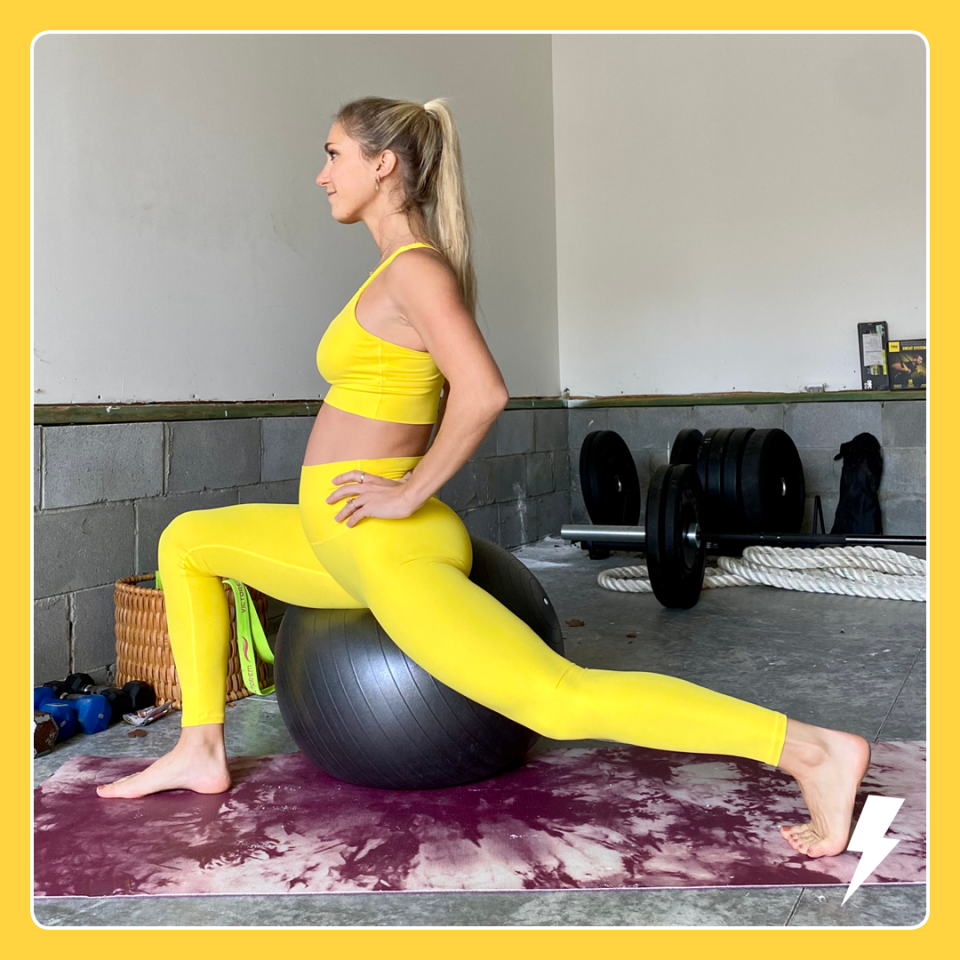
Why it rocks: This position brings benefits like the adductor stretch. It helps open the front of the pelvis and optimize its positioning for your baby during labor, says Pruett. “We want our pelvis to feel supple and open,” she explains.
How to:
Start in a lunge position with right leg forward and left leg behind with a stability ball between your legs. (Option to do this stretch near a couch or wall for stability.)
Place your right butt cheek on the stability ball with your right leg bent and stretch your left leg long behind you.
Hold for 10 to 30 seconds.
Carefully return to standing. That's one rep.
Complete 3 to 5 reps, then switch sides and repeat.
10. Seated Four Stretch

Why it rocks: “This stretch targets the piriformis, the muscle that attaches from the sacrum (the triangular bone in your pelvis) to the femur (the thigh bone),” says Pruett. It's important because the piriformis passes just behind the pelvic floor, and when it's tight so are the pelvic floor muscles, she explains. By releasing the piriformis, you allow the sacrum to be in its optimal position, in turn supporting proper pelvic floor functioning. “This is a stretch we don’t want to skip,” stresses Pruett.
How to:
Sit tall on a chair or a stability ball with a neutral pelvis.
Place your right ankle on the left knee with the right foot flexed.
Maintain a neutral pelvis and upright posture as you hinge forward at the hips until you feel a stretch deep in your hip and glutes
Hold this position for 10 to 30 seconds.
Switch legs and repeat.
Continue alternating for 3 to 5 reps on each side.
11. Hamstring Stretch With Band

Why it rocks: This stretch is designed to bring length to the hamstrings, says Pruett. The hamstrings originate from the sit bones (the pointy bones you feel under your glutes), and when the hamstrings are tight, they pull on the sit bones encouraging the pelvis to tip backwards and out of ideal alignment, she explains. “Remember, everything in our body is connected," says Pruett. "It’s even more important to keep the hamstrings long and stretched, especially with the increased sitting we may be doing while pregnant.”
How to:
Lie on your back with your head on a yoga block or pillow (this is especially important starting second trimester and on, stresses Pruett).
Maintain a neutral pelvis and hook a long band or yoga strap around the ball of your right foot, while holding the strap in each hand.
Keep the back of the left leg on the mat and the right leg as straight as possible while lifting the right up toward the ceiling until you feel your pelvis start to tip backward (this is a sign that your pelvis is moving out of a neutral position and where to stop, says Pruett).
Hold this position for 10 to 30 seconds.
Switch legs and repeat.
Continue alternating for 3 to 5 reps on each side.
You Might Also Like

